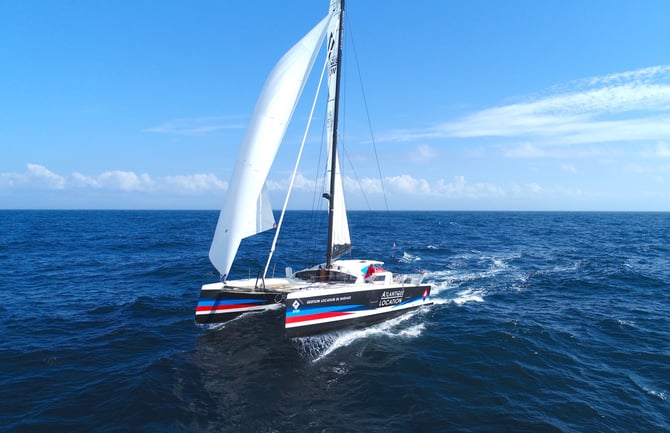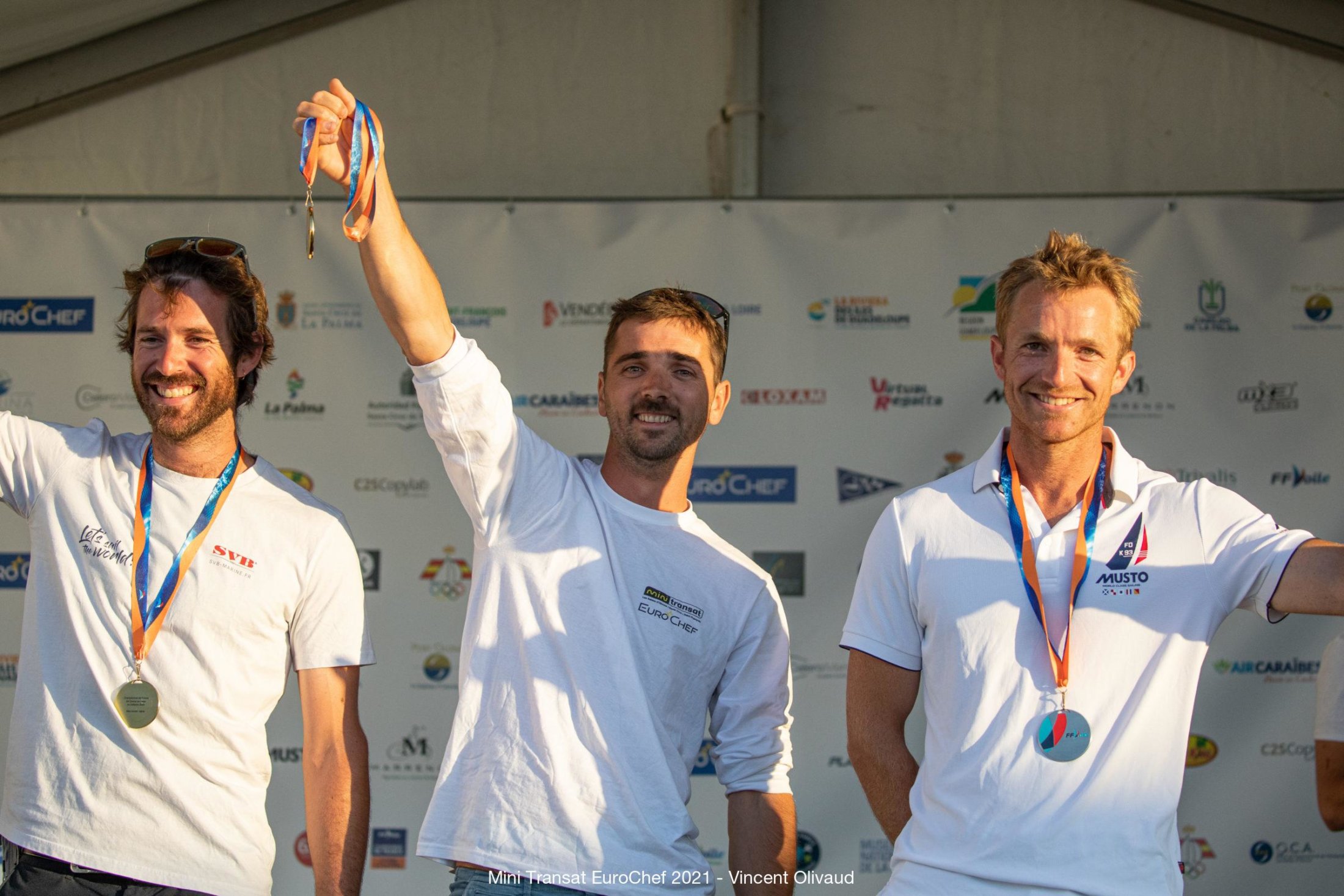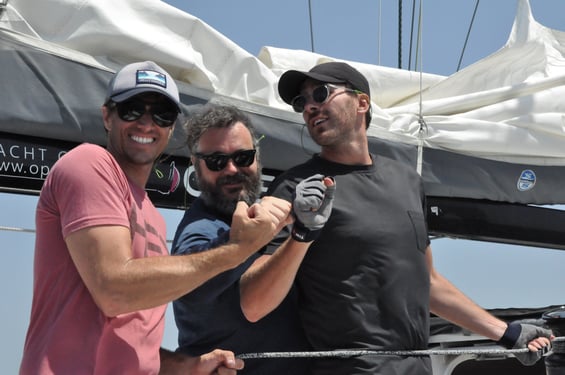In the world of sailing, there's a certain magic that comes alive when you push the boundaries, when the spray of the sea mingles with the thrill of the wind, when your sailboat cruises at high speeds. Welcome, dear adventurers, to the exhilarating realm of high-speed sailing.
Understanding High-Speed Sailing
High-speed sailing, cruising between 15 to 20 knots, is the sea-bound equivalent of flying without ever leaving the water. It's where adrenaline meets serenity, where the precision of your skills dances with the unpredictability of the elements. It's not just about going faster; it's about understanding the synergy between you, your vessel, and the vast expanse of the ocean.

Here is the TS42, the boat Sailing Virgins is teaching on, not your average cruising cat!
Now, let's talk about helming. Picture the helm as an artist's paintbrush. In unskilled hands, the result might be unpredictable, maybe even a little messy. But with the right techniques, it can create a masterpiece. Helming at high speeds is an art, a delicate balance of skill and intuition, and the better you master it, the more vibrant your seafaring adventures become.
Before we dive into the techniques, let's revisit some helming basics, shall we?
Recapping the Basics of Helming
The helm is your command center, your connection to the rudder, and your primary means of steering the boat. The term 'helming' refers to the act of steering the boat using the helm. Easy enough, right? But as the speed of your sailboat increases, so does the demand on your helming skills. It's like driving a car: anyone can steer a vehicle down a quiet country road, but it takes real skill to navigate a race car on a bustling track.
At high speeds, your inputs at the helm need to be more precise, more timely. The margin for error shrinks, and your reactions need to be quicker. Your understanding of the boat and the sea needs to be deeper. Helming at high speeds isn't just about moving the rudder; it's about feeling the boat, listening to the wind, and interpreting the waves.
Techniques for High-Speed Sailing
Remember, there's a certain finesse required when handling the helm at high speeds. Your actions need to be smooth and deliberate. Oversteering can lead to a loss of speed or, worse, a loss of control. It's a game of subtlety, a dance where the slightest misstep can change the rhythm entirely.
How to effectively use the sails and hull at high speeds
Using the sails and hull at high speeds is akin to an acrobat understanding his balance and the pull of gravity. You need to understand how the wind interacts with your sails, and how your hull cuts through the water. It's not just about catching the most wind; it's about using the wind effectively, maintaining the right angle to the wind, and adjusting your sails accordingly.
Tips for maintaining control of the boat at high speeds
Maintaining control of the boat at high speeds can be a thrilling challenge. The boat responds more quickly and forcefully to your actions at the helm. It's a test of your skills, your instincts, and your courage. But fear not, for every seasoned sailor has been where you are now.
Techniques for making quick, precise maneuvers
Mastering quick, precise maneuvers is essential. Whether it's tacking, jibing, or altering course to avoid a collision, your actions need to be fast and accurate. Remember, at high speeds, things happen quickly, and you need to stay one step ahead.
By now, you're probably thinking, "Well, this is a whole new ball game." And you're right, it is. But it's a game that brings a new level of excitement, a new depth of connection with the sea, and a new sense of achievement. And we believe you're ready for it.

Sailing Virgins Performance Instructor Hugo Picard (left) on the podium of 2021 Offshore Racing Championship.
And here you are, stepping into a realm that only a few dare to explore. But as you've embarked on this journey, remember, the sea is a force to be reckoned with. It demands respect, and it rewards those who take the time to understand it. High-speed sailing is an extension of this philosophy. It's not about conquering the waves but learning to dance with them.
As you become more comfortable with your helm, you'll start to notice subtle changes in your boat's behavior. A slight lean to one side might tell you the sails need adjusting, or a vibration in the tiller could indicate the onset of weather helm. These are the subtle dialogues between you and your vessel. The key to high-speed sailing is to listen to these whispers and respond with gentle precision.
Working with your Team
But let's not forget the role of the crew. While you are at the helm, they are your eyes and ears around the boat. They'll be adjusting the sails, keeping a lookout for potential hazards, and offering you valuable feedback. Your role as the helmsman or helmswoman is not just to steer the boat, but also to coordinate the crew. High-speed sailing is, in many ways, a team sport.

It's also about being proactive rather than reactive. If you see a gust of wind approaching, prepare your boat and crew for it. If you anticipate a wave, adjust your helm accordingly. The best high-speed sailors are those who are always one step ahead, those who blend foresight with skill.
Of course, mastering high-speed sailing won't happen overnight. It's a journey filled with trials, errors, and triumphs. But every knot you add to your speed, every successful maneuver, every moment when you feel in perfect harmony with the sea will bring a sense of achievement like no other.
Conclusion
As we wrap up this introduction to high-speed sailing and helming, we want to leave you with a sense of anticipation, a thirst for the thrill that awaits. This is just the beginning of your high-speed sailing journey, and there's much more to explore, much more to learn.
In the next installment of this series, we'll delve deeper into advanced strategies and safety measures for high-speed sailing. We'll explore how performance sailing techniques, safety precautions, weather considerations, and proper training can enhance your high-speed sailing experience.
As we set sail on this adventure, remember: the sea may be the canvas, but you are the artist. Your helm is your brush, and high-speed sailing is your masterpiece waiting to come to life. Keep practicing, keep learning, and most importantly, keep sailing. The horizon awaits you, sailor.
Want to join Hugo on a Performance Sailing Course?


